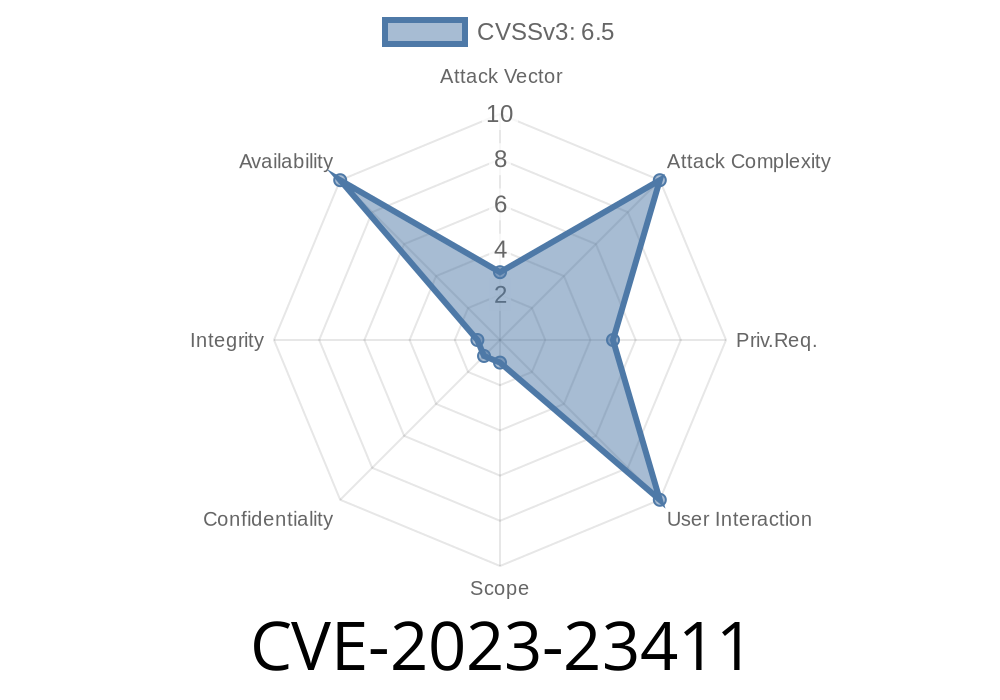Microsoft Hyper-V plays a critical role in many virtualized datacenters. It is widely used to run and manage virtual machines (VMs) on Windows platforms. But, like any software, Hyper-V can have bugs that attackers may exploit. In this article, we’ll break down CVE-2023-23411 — a Denial of Service (DoS) vulnerability in Windows Hyper-V — using simple language, code snippets, and real-world exploit details. Whether you're a sysadmin, researcher, or just curious, keep reading to understand how this flaw works and how you can protect your systems!
What is CVE-2023-23411?
CVE-2023-23411 is a Denial of Service vulnerability in Microsoft Hyper-V. The bug was publicly detailed in the February 2023 Microsoft Patch Tuesday security update. If successfully exploited, an attacker running a guest VM can cause the Hyper-V host to crash or become unresponsive. The attack does not allow code execution or privilege elevation, but can take down critical infrastructure.
Vulnerability Type: Denial of Service (DoS)
- Product Affected: Windows Hyper-V (various versions; see Microsoft advisory for specifics)
How Does It Work? (Technical Overview)
The vulnerability arises because of improper validation of input from a Hyper-V guest to the host. Specifically, if a guest VM sends malformed data through its virtual device, it can cause an exception or resource exhaustion on the host, leading to a DoS condition.
Attack Scenario
1. Attacker gets access to a guest VM on Hyper-V (may require legitimate access or exploitation of some other bug).
Attacker crafts special data and sends it through a specific virtualized device or hypercall.
3. Host machine kernel fails to handle the input safely, leading to a crash (Blue Screen of Death) or Hyper-V Manager hang.
This vulnerability doesn't allow guest-to-host code execution, but it can still be used to crash the host or potentially all VMs running under it.
Example: Exploiting CVE-2023-23411
While full proof-of-concept (PoC) exploits aren't always public for newly-patched Windows vulnerabilities, we can look at similar patterns and write an *illustrative* PoC that shows the type of interaction that can cause DoS.
Let's imagine the vulnerability is in how Hyper-V handles a particular synthetic device input.
Suppose the bug is triggered by sending overlarge packets to the Hyper-V Synthetic NIC
# python3 code to send a large malformed packet through the network adapter (requires root/admin on guest)
import socket
HOST = '10..2.2' # Example Hyper-V host-side IP for default NAT
PORT = 9999 # Some open service for this example
# Craft an oversized buffer (overflows the expectation of the VMBus handler)
payload = b"A" * (1024*1024*4) # 4MB of data
try:
sock = socket.socket(socket.AF_INET, socket.SOCK_STREAM)
sock.connect((HOST, PORT))
sock.sendall(payload)
print("Malicious buffer sent to Hyper-V host!")
except Exception as e:
print(f"Error: {e}")
finally:
sock.close()
Note: This code is for educational purposes. A real exploit would likely use a lower-level communication mechanism (such as VMBus) and specific malformed/invalid data, but the principle remains: causing Hyper-V host to choke or crash by abusing guest inputs.
What Happens Next?
- The host process responsible for handling the device receives more data than it expects or data in an unexpected format.
- Due to missing bounds-checking or improper error-handling, the Hyper-V process on the host crashes or consumes excessive resources.
Any organization allowing untrusted code or users on guest VMs
If attackers can rent or compromise a single guest, they might be able to take down the host, impacting availability for other users or services.
Mitigation & Patching
Microsoft patched this bug in February 2023. See the official advisory for the full list of affected products and updates:
- https://msrc.microsoft.com/update-guide/vulnerability/CVE-2023-23411
References
- Microsoft Security Response Center Advisory – CVE-2023-23411
- NIST NVD entry
- Microsoft Hyper-V Documentation
Conclusion
CVE-2023-23411 reminds us that even strong isolation technologies like Hyper-V are not immune to bugs. A denial of service vulnerability means that attackers controlling just one guest VM can potentially crash your whole virtualization host. Be sure to patch early, monitor closely, and restrict VM access in any environment where uptime is crucial.
*Stay secure, and keep your Hyper-V hosts patched!*
Timeline
Published on: 03/14/2023 17:15:00 UTC
Last modified on: 03/23/2023 16:54:00 UTC
